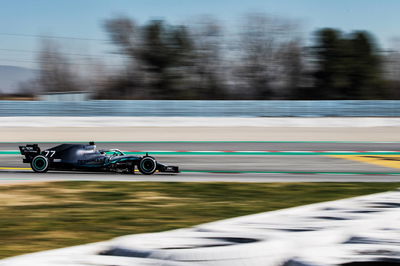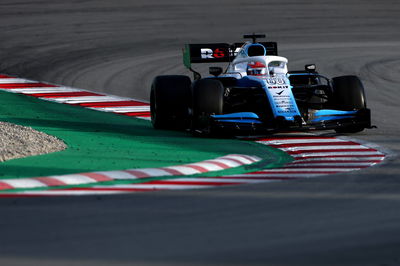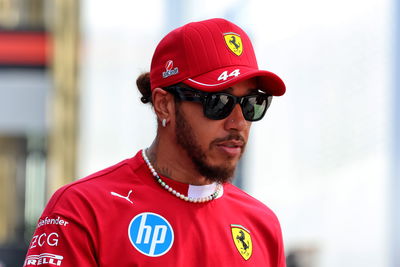F1 Testing Analysis: Ferrari begins to show its hand
The penultimate day of Formula 1’s pre-season test running in Barcelona saw times tumble towards the end of the morning session, with Ferrari giving another signal that it looks in good shape heading to Melbourne.
After its running on Wednesday was limited following Sebastian Vettel’s hefty crash - now known to be the result of a wheel rim failure - Ferrari turned its attention to racking up as much mileage as possible, scrapping plans to split running between its drivers in favour of full days for Charles Leclerc and Sebastian Vettel on Thursday and Friday respectively.
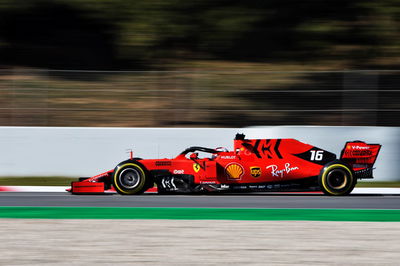
The penultimate day of Formula 1’s pre-season test running in Barcelona saw times tumble towards the end of the morning session, with Ferrari giving another signal that it looks in good shape heading to Melbourne.
After its running on Wednesday was limited following Sebastian Vettel’s hefty crash - now known to be the result of a wheel rim failure - Ferrari turned its attention to racking up as much mileage as possible, scrapping plans to split running between its drivers in favour of full days for Charles Leclerc and Sebastian Vettel on Thursday and Friday respectively.
Leclerc ticked all the boxes he needed to on his final day in the Ferrari SF90 car prior to the first race of the year in Melbourne. The morning was spent pushing for more short runs before switching to race simulations in the afternoon, with his pace across both outings impressing. A stoppage with 20 minutes left on the clock due to an exhaust issue brought his day to an early end, but with 138 laps completed, Leclerc did plenty to make up for the lost running earlier in the week.
Leclerc’s timesheet-topping time of 1m16.231s - just a tenth shy of the fastest ever lap of the Circuit de Barcelona-Catalunya, set last year by Lewis Hamilton - came amid a flurry of fast efforts on a variety of tyres and fuel loads. But through each of the runs, Leclerc stood clear of the rest.
While both Alexander Albon and Lando Norris managed to beat the existing pre-season benchmark with low-fuel runs on the soft tyres (C5 and C4 respectively), Leclerc initially drew close to them with a 1m17.2s effort despite being on the harder C2s. Adjusting by Pirelli’s guidelines, his optimum time appeared to be close to a 1m16s dead.
Leclerc gave us a sign of what he could truly do when he made the switch to the softest available tyre, the C5, and did a series of short runs across the course of which he improved his time. The final result was the 1m16.231s lap that would be good enough for top spot come the end of the day by a comfortable margin of six-tenths of a second.
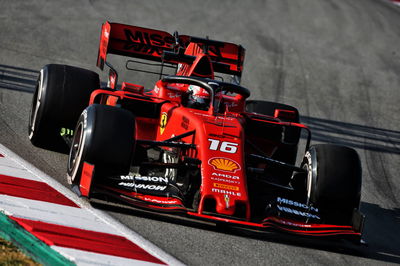
Was it a true signal of where Ferrari stood right now? Leclerc was certain that there was still time in the car, while remaining cautious of what Ferrari’s rivals were up to.
“I think as every team, we are not flat out,” said Leclerc. “There’s still some margin, a bit obviously in myself. I still have to learn, I get more comfortable with the car lap after lap and with the car itself, so it’s looking good for now.
“I think we are looking strong at the moment. Whether they are sandbagging more or less, we don’t know, and we’ll only know in qualifying in Melbourne.
“But for now, we are pretty happy with the job we’re doing.”
Any true comparison over a single lap between Ferrari and Mercedes was impossible to draw as, yet again, Mercedes chose to focus on long-run pace. Having lamented a front tyre graining issue over long runs through much of testing, the team prioritised getting to the bottom of the matter before turning its attention to one-lap performance on Friday. Mercedes made a sizeable step in its race simulations between Tuesday and Wednesday, boosting its confidence after an up and down start to testing.
After Lewis Hamilton completed the morning running, Valtteri Bottas took over the reins of the Mercedes W10 for the afternoon to complete his race simulation, giving a chance for a set comparison with Leclerc as he also put in a full distance during his final test appearance.
Bottas did his first long run on the C3 compound tyre before two runs on the C2, while Leclerc opted for a trio of C2 runs. The pair both had a couple of traffic laps (left out of the number crunching), and also had runs interrupted by the red flag for Pierre Gasly’s crash. This came at the end of Leclerc’s first stint, and four laps in to Bottas’ third stint.
Valtteri Bottas Stint Averages
Stint 1: 1m23.76s (C3)
Stint 2: 1m22.58s (C2)
Stint 3: 1m21.21 (C2)
Charles Leclerc Stint Averages
Stint 1: 1m23.27s (C2)
Stint 2: 1m22.13s (C2)
Stint 3: 1m21.21s (C2)
Leclerc ran half a second quicker in his first race stint than Bottas’, and was four-tenths up through his second run. It swung back in Bottas’ favour for the final stint as he edged Leclerc by one-tenth of a second.
The numbers bode well for Ferrari in a way they didn’t this time last year, but must naturally be taken with a pinch of salt. Running a similar methodology towards the end of testing last year, Mercedes was predicted to be well clear of both Ferrari and Red Bull - and even privately thought it was - before Ferrari turned up the wick, won the first two races, and took three of the first four poles on offer, catching Mercedes by surprise.
Today was likely the final chance we’ll get to draw a straight comparison between Ferrari and Mercedes, assuming the latter puts all of its efforts into qualifying efforts tomorrow to make up for all of its long running so far this week.
Mercedes has made good progress this week - but right now, on face value, it looks like it may not quite be enough to bridge the gap to Ferrari at the front.
